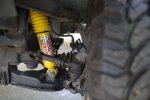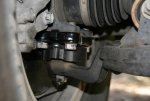BMarino
New member
Hi everyone!
Planning on buying a 1994 Toyota Pickup, with the 22-RE 2.4L, manual, 4x4.
I previously had a 2003 Tacoma and got rid of it recently due to the lower ball joint failure issue. I agree with what was said on some forums on the fact that this is a design flaw, not a manufacturing defect. I didn't want to be driving a truck without being able to have peace of mind on my safety and others' safety on the road.
As said now I'm considering buying a pre-Tacoma Toyota pickup (1994). However, it seems to me their IFS design is exactly the same as the 95-2004 Tacomas (check out the three photos below, first two from a 1989 truck, third one from a 1st gen Tacoma). At least the lower ball joint seems to me to be the exact same design as the 1st gen Tacomas'. In spite of this, I have not seen any report pertaining those earlier pickups on having the lower ball joint failure issue as the Tacomas do.
Could someone here please give me any knowledgeable feedback on this? If I'm gonna buy another Toyota pickup, I wanna make sure it's not gonna have that same issue as the 1st gen Tacomas.
Thanks a lot, and cheers from Mexico!
Bernardo.
Planning on buying a 1994 Toyota Pickup, with the 22-RE 2.4L, manual, 4x4.
I previously had a 2003 Tacoma and got rid of it recently due to the lower ball joint failure issue. I agree with what was said on some forums on the fact that this is a design flaw, not a manufacturing defect. I didn't want to be driving a truck without being able to have peace of mind on my safety and others' safety on the road.
As said now I'm considering buying a pre-Tacoma Toyota pickup (1994). However, it seems to me their IFS design is exactly the same as the 95-2004 Tacomas (check out the three photos below, first two from a 1989 truck, third one from a 1st gen Tacoma). At least the lower ball joint seems to me to be the exact same design as the 1st gen Tacomas'. In spite of this, I have not seen any report pertaining those earlier pickups on having the lower ball joint failure issue as the Tacomas do.
Could someone here please give me any knowledgeable feedback on this? If I'm gonna buy another Toyota pickup, I wanna make sure it's not gonna have that same issue as the 1st gen Tacomas.
Thanks a lot, and cheers from Mexico!
Bernardo.



